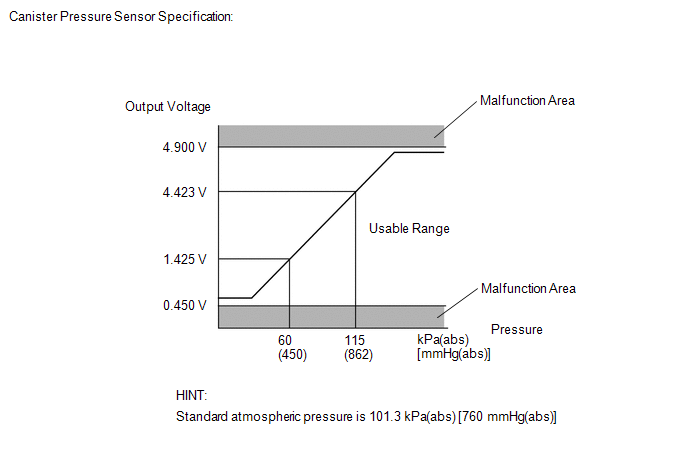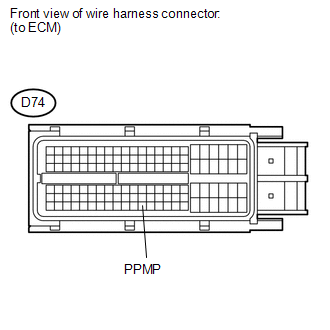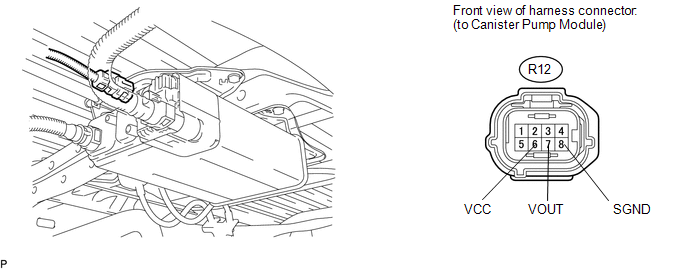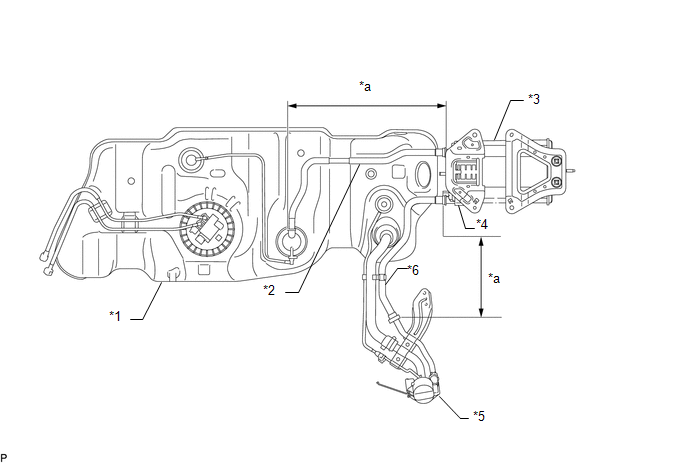DTC SUMMARY |
DTC No. | Monitoring Item |
Malfunction Detection Condition |
Trouble Area | Detection Timing |
Detection Logic | |
P0451 | Canister pressure sensor noise |
Sensor output voltage fluctuates frequently within certain time period. |
|
- EVAP monitoring (ignition switch off)
- Engine running
| 2 trip | |
P0451 | Canister pressure sensor becomes fixed/flat |
Sensor output voltage does not vary in a certain time period. |
|
- EVAP monitoring (ignition switch off)
| 2 trip | |
P0452 | Canister pressure sensor low input |
EVAP pressure Below 42.1 kPa for 0.5 seconds. |
|
- Ignition switch ON
- EVAP monitoring (ignition switch off)
| 1 trip | |
P0453 | Canister pressure sensor high input |
EVAP pressure higher than 123.8 kPa for 0.5 seconds. |
|
- Ignition switch ON
- EVAP monitoring (ignition switch off)
| 1 trip |
HINT: The canister pressure sensor is built into the canister pump module. DESCRIPTION
The description can be found in the EVAP (Evaporative Emission) system (See page
 ). ). MONITOR DESCRIPTION

- DTC P0451: Canister pressure sensor noise or fixed/flat
If the canister pressure sensor voltage output
fluctuates rapidly for 10 seconds, the ECM stops the EVAP system
monitor. The ECM interprets this as noise from the canister pressure
sensor, and stops the EVAP system monitor. The ECM then illuminates the
MIL and stores the DTC (2 trip detection logic).
Alternatively,
if the sensor voltage output does not change for 10 seconds, the ECM
interprets this as the sensor being stuck, and stops the monitor. The
ECM then illuminates the MIL and stores the DTC (both malfunctions are
detected by 2 trip detection logic).
- DTC P0452: Canister pressure sensor voltage low
If the canister pressure sensor voltage output
(pressure) is less than 0.45 V: 42.1 kPa-a (315.8 mmHg-a), the ECM
interprets this as an open or short circuit malfunction in the canister
pressure sensor or its circuit, and stops the EVAP system monitor. The
ECM then illuminates the MIL and stores the DTC (1 trip detection
logic).
- DTC P0453: Canister pressure sensor voltage high
If the canister pressure sensor voltage output
(pressure) is higher than 4.9 V: 123.8 kPa-a (928.6 mmHg-a), the ECM
interprets this as an open or short circuit malfunction in the canister
pressure sensor or its circuit, and stops the EVAP system monitor. The
ECM then illuminates the MIL and stores the DTC (1 trip detection
logic).
MONITOR STRATEGY |
Required Sensors/Components | Canister pump module | |
Frequency of Operation | Continuous | |
Duration | Within 15 seconds: P0451 sensor noise
Within 2 minutes: P0451 sensor fixed/flat 0.5 seconds: P0452 and P0453 | |
MIL Operation | Immediate: P0452 and P0453
2 driving cycles: P0451 | | Sequence of Operation |
None | TYPICAL ENABLING CONDITIONS P0451 (Noise Monitor) |
Monitor runs whenever following DTCs not present |
P0452, P0453 (EVAP system) | | Atmospheric pressure (absolute pressure) |
70 to 110 kPa-a (525 to 825 mmHg-a) | |
Battery voltage | 10.5 V or higher | |
Intake air temperature | 4.4 to 40°C (40 to 104°F) | |
Either of following conditions met | A or B | |
A. Engine condition | Running | |
B. Time after key off | 5, 7 or 9.5 hours | P0451 (Fixed/Flat Monitor) |
Monitor runs whenever following DTCs not present |
P0452, 0453 (EVAP system) | | Battery voltage |
10.5 V or higher | | Intake air temperature |
4.4 to 40°C (40 to 104°F) | |
Atmospheric pressure (absolute pressure) |
70 to 110 kPa-a (525 to 825 mmHg-a) | |
Time after key off | 5, 7 or 9.5 hours | P0452 and P0453 |
Monitor runs whenever following DTCs not present |
None | | Battery voltage |
8 V or higher | | Starter |
OFF | | Either of following conditions met |
(a) or (b) | | (a) Ignition switch |
ON | | (b) Soak timer |
ON | TYPICAL MALFUNCTION THRESHOLDS P0451: Canister Pressure Sensor Noise |
Frequency that EVAP pressure changes 0.3 kPa-g (2.25 mmHg-g) or higher |
10 times or more in 10 seconds | P0451: Canister Pressure Sensor Voltage Fixed |
EVAP pressure change during reference pressure measurement |
Below 0.65 kPa-a (4.87 mmHg-a) | P0452: Canister Pressure Sensor Low Voltage |
EVAP pressure sensor voltage | Less than 0.45 V [42.1 kPa-a (315.8 mmHg-a)] | P0453: Canister Pressure Sensor High Voltage |
EVAP pressure sensor voltage | Higher than 4.9 V [123.8 kPa-a (928.6 mmHg-a)] | CONFIRMATION DRIVING PATTERN
NOTICE:
- The Evaporative System Check (Automatic Mode) consists of 6 steps
performed automatically by the Techstream. It takes a maximum of
approximately 24 minutes.
- Do not perform the Evaporative System Check when the fuel tank is more
than 90% full because the cut-off valve may be closed, making the fuel
tank leak check unavailable.
- Do not run the engine during this operation.
- When the temperature of the fuel is 35°C (95°F) or higher, a large
amount of vapor forms and any check results become inaccurate. When
performing the Evaporative System Check, keep the fuel temperature below
35°C (95°F).
- Connect the Techstream to the DLC3.
- Turn the ignition switch to ON and turn the Techstream on.
- Enter the following menus: Powertrain / Engine and ECT / Data List / Intake Air.
- Clear DTCs (even if no DTCs are stored, perform the clear DTC operation).
- Turn the ignition switch off and wait for at least 30 seconds.
- Turn the ignition switch to ON and turn the Techstream on.
- Enter the following menus: Powertrain / Engine and ECT / Utility / Evaporative System Check / Automatic Mode.
- After the "Evaporative System Check" is completed, check All Readiness
by entering the following menus: Powertrain / Engine and ECT / Utility /
All Readiness.
- Input the DTC: P0451, P0452 or P0453.
- Check the DTC judgment result.
|
Tester Display |
Description |
|
NORMAL |
- DTC judgment completed
- System normal
|
|
ABNORMAL |
- DTC judgment completed
- System abnormal
|
|
INCOMPLETE |
- DTC judgment not completed
- Perform driving pattern after confirming DTC enabling conditions
|
|
N/A |
- Unable to perform DTC judgment
- Number of DTCs which do not fulfill DTC preconditions has reached ECU memory limit
|
HINT:
If the judgment result shows ABNORMAL, the system has a malfunction.
- If the test result is INCOMPLETE or N/A and no pending DTC is output,
perform a universal trip and check for permanent DTCs (See page
 ). ).
HINT:
- If a permanent DTC is output, the system is malfunctioning.
- If no permanent DTC is output, the system is normal.
WIRING DIAGRAM Refer to the EVAP system (See page
 ). ). CAUTION / NOTICE / HINT
NOTICE:
- When a vehicle is brought into the workshop, leave it as it is. Do not
change the vehicle condition. For example, do not tighten the fuel cap.
- The Techstream is required to conduct the following diagnostic troubleshooting procedure.
PROCEDURE |
1. | CONFIRM DTC AND EVAP PRESSURE |
(a) Connect the Techstream to the DLC3. (b) Turn the ignition switch to ON (do not start the engine).
(c) Turn the Techstream on. (d) Enter the following menus: Powertrain / Engine and ECT / Trouble Codes.
(e) Read DTCs. (f) Enter the following menus: Powertrain / Engine and ECT / Data List / Vapor Pressure Pump.
(g) Read the EVAP (Evaporative Emission) pressure displayed on the Techstream. Result |
Result | Test Result |
Suspected Trouble Area | Proceed to | |
P0451 | - |
Canister pressure sensor |
C | | P0452 |
Below 42.1 kPa-a (315.8 mmHg-a) |
- Wire harness/connector (ECM - Canister pressure sensor)
- Canister pressure sensor
- Short in ECM circuit
| A | |
P0453 | Higher than 123.8 kPa-a (928.6 mmHg-a) |
- Wire harness/connector (ECM - Canister pressure sensor)
- Canister pressure sensor
- Open in ECM circuit
| B |
| B |
 | GO TO STEP 4 |
| C |
 | GO TO EVAP SYSTEM |
|
A |
 | |
| 2. |
CHECK HARNESS AND CONNECTOR (CANISTER PUMP MODULE - ECM) |
 (a) Turn the ignition switch off.
(b) Disconnect the ECM connector. (c) Measure the resistance according to the value(s) in the table below. Result |
Tester Connection | Condition |
Specified Condition | Suspected Trouble Area |
Proceed to | | D74-121 (PPMP) - Body ground |
Always | 10 Ω or less |
- Wire harness/connector (ECM - Canister pressure sensor)
- Short in canister pressure sensor circuit
| A | |
D74-121 (PPMP) - Body ground |
Always | 10 kΩ or higher |
- Wire harness/connector (ECM - Canister pressure sensor)
- Short in ECM circuit
| B |
| B |
 | GO TO STEP 7 |
|
A |
 | |
| 3. |
CHECK HARNESS AND CONNECTOR (CANISTER PUMP MODULE - ECM) |
(a) Disconnect the canister pump module connector. (b) Disconnect the ECM connector.
(c) Measure the resistance according to the value(s) in the table below. Result |
Tester Connection | Condition |
Specified Condition | Suspected Trouble Area |
Proceed to | | D74-121 (PPMP) - Body ground |
Always | 10 kΩ or higher |
Short in canister pressure sensor circuit |
A | | D74-121 (PPMP) - Body ground |
Always | 10 Ω or less |
Short in wire harness/connector (ECM - Canister pressure sensor) |
B |
| A |
 | GO TO STEP 5 |
| B |
 | GO TO STEP 6 |
| 4. |
CHECK HARNESS AND CONNECTOR (CANISTER PUMP MODULE - ECM) |
 (a) Disconnect the canister pump module connector.
(b) Measure the resistance according to the value(s) in the table below.
Standard Resistance: |
Tester Connection | Condition |
Specified Condition | |
R12-8 (SGND) - Body ground |
Always | 100 Ω or less |
(c) Turn the ignition switch to ON. (d) Measure the voltage according to the value(s) in the table below.
Standard Voltage: |
Tester Connection | Switch Condition |
Specified Condition | |
R12-6 (VCC) - Body ground |
Ignition switch ON | 4.5 to 5.5 V | |
R12-7 (VOUT) - Body ground |
Ignition switch ON | 4.5 to 5.5 V | Result |
Result | Suspected Trouble Area |
Proceed to | | Voltage and resistance within standard ranges |
Open in canister pressure sensor circuit |
A | | Voltage and resistance outside standard ranges |
Open in wire harness/connector (ECM - Canister pressure sensor) |
B |
| B |
 | GO TO STEP 6 |
|
A |
 | |
| 5. |
REPLACE CANISTER PUMP MODULE | (a) Replace the canister pump module (See page
 ). ).
NOTICE:
- When replacing the canister pump module, check the canister pump module
interior, canister interior and related pipes for water, fuel and other
liquids. If liquids are present, check for disconnections and/or cracks
in the following: 1) the pipe from the air inlet port to the canister
pump module; 2) the canister filter; and 3) the fuel tank vent hose. If
liquids are present in the canister interior, replace the canister and
canister pump module together.
- Check for filter blockage in the canister. If the charcoal filter inside
the canister is clogged, replace the canister and canister pump module
together.
- Check for filter blockage in the canister filter. If the canister filter
has blockages, replace the fuel tank inlet pipe sub-assembly.
 Text in Illustration Text in Illustration |
*1 | Fuel Tank |
*2 | Fuel Tank Vent Hose | |
*3 | Canister Assembly |
*4 | Canister Pump Module - Canister Pressure Sensor
- Leak Detection Pump - Vent Valve | |
*5 | Fuel Tank Inlet Pipe Sub-assembly (Canister Filter) |
*6 | Canister Outlet Hose | |
*a | Inspection Area (check for disconnection and/or cracks) |
- | - |
| NEXT |
 | GO TO STEP 8 |
| 6. |
REPAIR OR REPLACE HARNESS OR CONNECTOR (CANISTER PUMP MODULE - ECM) |
HINT: If the exhaust tailpipe has been removed, go to the next step before reinstalling it.
| NEXT |
 | GO TO STEP 8 |
(a) Replace the ECM (See page
 ). ).
|
NEXT |
 | |
| 8. |
CHECK WHETHER DTC OUTPUT RECURS (AFTER REPAIR) |
(a) Connect the Techstream to the DLC3. (b) Turn the ignition switch to ON.
(c) Turn the Techstream on. (d) Clear the DTCs (See page
 ). ). (e) Turn the ignition switch off and wait for at least 30 seconds.
(f) Turn the ignition switch to ON and turn the Techstream on. (g) Start the engine and warm it up.
(h) Drive the vehicle in accordance with the driving pattern described in the Confirmation Driving Pattern.
(i) Enter the following menus: Powertrain / Engine and ECT / Utility / All Readiness.
(j) Input the DTC: P0451, P0452 or P0453. (k) Check the DTC judgment result. |
Techstream Display | Description | |
NORMAL |
- DTC judgment completed
- System normal
| | ABNORMAL |
- DTC judgment completed
- System abnormal
| | INCOMPLETE |
- DTC judgment not completed
- Perform driving pattern after confirming DTC enabling conditions
| | N/A |
- Unable to perform DTC judgment
- Number of DTCs which do not fulfill DTC preconditions has reached ECU's memory limit
|
| NEXT |
 | END | | 


 Text in Illustration
Text in Illustration